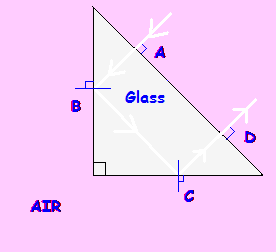45o
Prisms used to change a ray's direction
A 45o prism
can turn a ray through 90o or through 180o
When drawing these
diagrams use a ruler and a protractor and ensure your digrams are neat
and large enough to label accurately. Always tell the examiner what is
happening at each boundary.
Turning a ray through
90o

- At boundary A the
angle of incidence is 0o therefore the ray goes through undeviated.
- At boundary B the
angle of incidence is 45o therefore the ray undergoes total
internal reflection as it is a bigger angle than the critical angle
of glas (42o).
- At boundary C the
angle of incidence is 0o therefore the ray goes through undeviated.
Turning
a ray through 180o

- At boundary A the
angle of incidence is 0o therefore the ray goes through undeviated.
- At boundary B the
angle of incidence is 45o therefore the ray undergoes total
internal reflection as it is a bigger angle than the critical angle
of glas (42o).
- At boundary Cthe
angle of incidence is 45o therefore the ray undergoes total
internal reflection as it is a bigger angle than the critical angle
of glas (42o).
- At boundary D the
angle of incidence is 0o therefore the ray goes through undeviated.
Don't forget that
each segment of the ray needs an arrow (only one!) and don't forget to
construct normals where the ray hits the boundary.
The advantage of using
a prism rather than mirrors to change the path of the ray is that 100%
of the light energy changes direction - there is no absorption at each
boundary as there would be with normal reflection.
.








